art | architecture | design | digital | gallery | illustration | music | painting | photography | sculpture | video
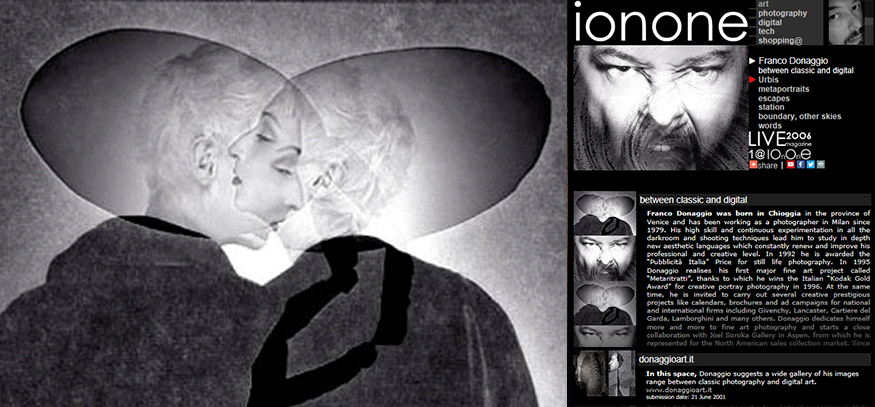
Franco Donaggio was born in Chioggia in the province of Venice and has been working as a photographer in Milan since 1979. His high skill and continuous experimentation in all the darkroom and shooting techniques lead him to study in depth new aesthetic languages which constantly renew and improve his professional and creative level. In 1992 he is awarded the “Pubblicità Italia” Price for still life photography. In 1995 Donaggio realises his first major fine art project called “Metaritratti”, thanks to which he wins the Italian “Kodak Gold Award” for creative portray photography in 1996. At the same time, he is invited to carry out several creative prestigious projects like calendars, brochures and ad campaigns for national and international firms including Givenchy, Lancaster, Cartiere del Garda, Lamborghini and many others. Donaggio dedicates himself more and more to fine art photography and starts a close collaboration with Joel Soroka Gallery in Aspen, from which he is represented for the North American sales collection market. Since then, he has attended the principal photo-art trade fairs through the United States, such as 'Photo LA', Los Angeles, 'AIPAD show', New York, 'Art Fair, Chicago'. Donaggio’s fine art works have been hosted in numerous Italian galleries and museums and some of his photographs are included in several public and private photo collections: Bibliothèque Nationale de France, Collezione 3M, Collezione Scavi Scaligeri, Saudi Royal Family’s Private Collection, to name just a few. Lots of magazines in Italy, Europe and United States have published the artist’s creative profile. Donaggio is represented by the ‘Joel Soroka Gallery’ in Aspen, by the ‘Benham Gallery’ in Seattle and by the Galerie Celal in Paris for the fine art sale in the United States. read more »
www.francodonaggio.it
The work of photographer Agnes Donnadieu has been called brooding and sexy, edgy and glamorous, erotic and slick. It's also been called "European." What nobody has ever called it is "Midwestern," though Donnadieu has lived and worked in Chicago for the last 9 years. Donnadieu's photos tend to be dark and shadowy. Her images of people appear unposed, yet the composition is graphic, candid, without being contrived. The dramatic look of her photos is due in part to her direct lighting technique. read more »
www.donnadieustudio.com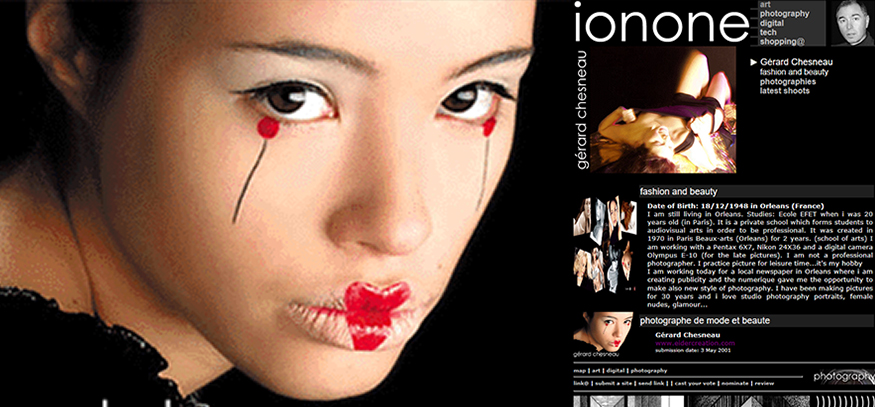
Date of Birth: 18/12/1948 in Orleans (France).
I am still living in Orleans. Studies: Ecole EFET when i was 20 years old (in Paris). It is a private school which forms students to audiovisual arts in order to be professional. It was created in 1970 in Paris Beaux-arts (Orleans) for 2 years. (school of arts) I am working with a Pentax 6X7, Nikon 24X36 and a digital camera Olympus E-10 (for the late pictures). I am not a professional photographer. I practice picture for leisure time...it's my hobby
I am working today for a local newspaper in Orleans where i am creating publicity and the numerique gave me the opportunity to make also new style of photography. I have been making pictures for 30 years and i love studio photography portraits, female nudes, glamour ...
read more »
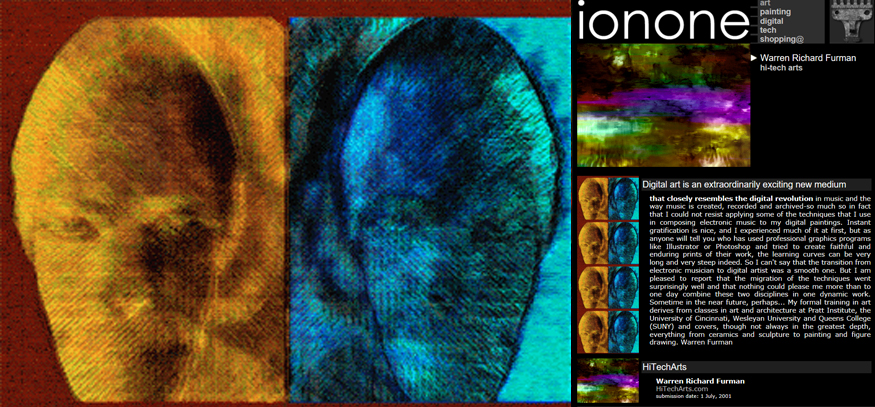
Digital art is an extraordinarily exciting new medium that closely resembles the digital revolution in music and the way music is created, recorded and archived-so much so in fact that I could not resist applying some of the techniques that I use in composing electronic music to my digital paintings. Instant gratification is nice, and I experienced much of it at first, but as anyone will tell you who has used professional graphics programs like Illustrator or Photoshop and tried to create faithful and enduring prints of their work, the learning curves can be very long and very steep indeed. So I can't say that the transition from electronic musician to digital artist was a smooth one. But I am pleased to report that the migration of the techniques went surprisingly well and that nothing could please me more than to one day combine these two disciplines in one dynamic work. Sometime in the near future, perhaps... My formal training in art derives from classes in art and architecture at Pratt Institute, the University of Cincinnati, Wesleyan University and Queens College (SUNY) and covers, though not always in the greatest depth, everything from ceramics and sculpture to painting and figure drawing. Warren Furman
web.axelero.hu/kegri
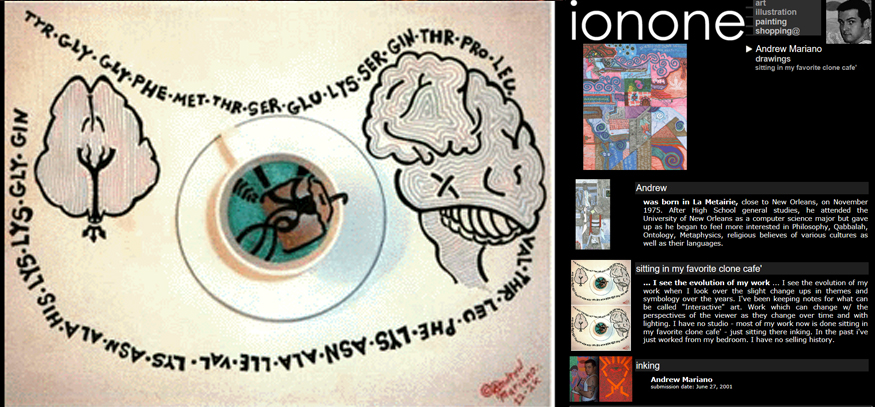
... I see the evolution of my work ... I see the evolution of my work when I look over the slight change ups in themes and symbology over the years. I've been keeping notes for what can be called "Interactive" art. Work which can change w/ the perspectives of the viewer as they change over time and with lighting. I have no studio - most of my work now is done sitting in my favorite clone cafe' - just sitting there inking. In the past i've just worked from my bedroom. I have no selling history.
Andrew was born in La Metairie, close to New Orleans, on November 1975. After High School general studies, he attended the University of New Orleans as a computer science major but gave up as he began to feel more interested in Philosophy, Qabbalah, Ontology, Metaphysics, religious believes of various cultures as well as their languages

Dan Stewart, once the best kept secret in country music; is about to blow his cover with the release of his new album “Thank You” He left country music’s Mecca, Nashville, for the glitter of Las Vegas. While in Nashville he recorded demos for several of the industry’s top music companies and then decided to strike out on his own. Many of his songs have hit the airwaves on country radio: on mega-station KZLA in Los Angeles and the Interstate Radio Network out of Nashville. Always creating an immediate buzz with listeners and effusive praise from the disc jockeys; Dan has a steadfast belief in his ability with a song and he always knew that if he could just get it heard , that would be half the battle. With the advent of Internet sites like MP3.com and it’s legion of imitators, Dan saw an opportunity to take his music to his most enthusiastic supporters - the listeners. Posting his music on the site , he began moving up the charts with upwards of 200 hits per day. Soon, his songs “Thank You’ and “Nothing But Your Lovin’ Will Do” were gaining him featured artist status on MP3 sites all over the Web and the World. Dan is currently represented by renowned entertainment attorney, Owen J. Sloane, whose glittering talent roster includes Matchbox 20, Elton John and Kenny Rogers. He and Sloane plan a showcase in Nashville in the near future and a recording session of new songs. read more @ reverbnation.com »

The portraits, fashion and fine art images of photographer Patrick Demarchelier.
read more »
Patrick Demarchelier: Photographs
Patrick Demarchalier
Patrick Demarchelier: Forms
Patrick Demarchelier (Stern Portfolio Library of Photography)
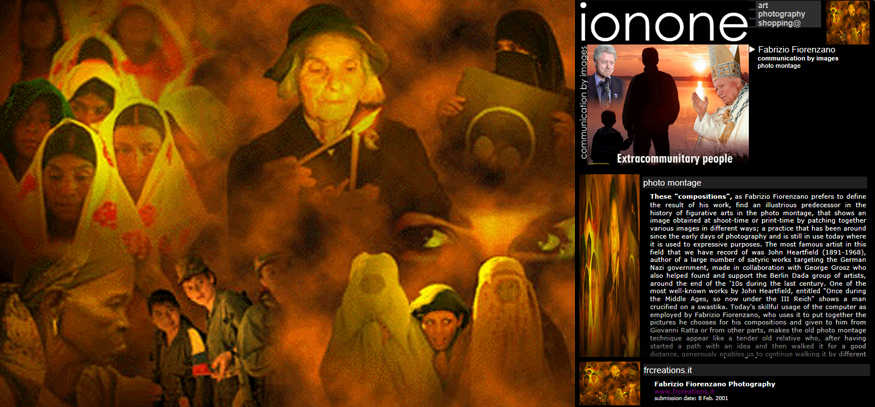
These "compositions", as Fabrizio Fiorenzano prefers to define the result of his work, find an illustrious predecessor in the history of figurative arts in the photo montage, that shows an image obtained at shoot-time or print-time by patching together various images in different ways; a practice that has been around since the early days of photography and is still in use today where it is used to expressive purposes. The most famous artist in this field that we have record of was John Heartfield (1891-1968), author of a large number of satyric works targeting the German Nazi government, made in collaboration with George Grosz who also helped found and support the Berlin Dada group of artists, around the end of the '10s during the last century. One of the most well-known works by John Heartfield, entitled "Once during the Middle Ages, so now under the III Reich" shows a man crucified on a swastika. Today's skillful usage of the computer as employed by Fabrizio Fiorenzano, who uses it to put together the pictures he chooses for his compositions and given to him from Giovanni Ratta or from other parts, makes the old photo montage technique appear like a tender old relative who, after having started a path with an idea and then walked it for a good distance, generously enables us to continue walking it by different means. Indeed, the results achievable through electronics are amazing for number of colours, infinitely adjustable shades, transparent veils, number of usable backgrounds, available filters, range of effects and much more - all tools that are not available in the darkroom and that can be precisely applied at each instance, without the unpredictability of chemicals. Fascinating world of possibilites in which creativity, talent, emotion and synthetical skills get along perfectly with intelligence, reflection, technique and play. The result of Fabrizio's work appears consolidated by now, and if we abandon ourselves to the reading of his works packed with atmosphere and deep tension in regards to the inequality of the world, the woman's condition in third world countries and the obtuseness of wars, as well as beauty, nature, abstractions, dream and contradictions, then we can enjoy the enchanted birth of an "image of images" which allows us to raise our awareness and communicate without words. Luciano D’Alessandro (Photographer)
read more »
INTRODUCTION
According to conventional wisdom, the Villa Emo at Fanzolo could never have been based on Golden proportions. I could not believe this myself—not, that is, until I saw the entire mathematical scheme for Palladio's elegant Renaissance buildings, which sit on a flat, fertile plain in Treviso, in northern Italy [Fletcher 2000].
In "Palladio's Villa Emo:The Golden Proportion Hypothesis Rebutted" [March 2001], Lionel March argues that the Golden Section, or extreme and mean ratio, is nowhere to be found in the Villa Emo as described in I quattro libri dell'archittetura. Palladio, he says, "has given the actual measurements" and they simply do not add to a scheme of Golden proportions. He is absolutely right. The extreme and mean ratio is not observed in the Emo plan as it was published. But the villa Palladio described in that publication is not the villa he built and that survives today.
The discrepancy between the two versions was known as early as the 1770s. That was when Bertotti Scamozzi published Le fabbriche e i disegni di Andrea Palladio, in which he struggled to reconcile numerous inconsistencies between built and published versions of Palladio's works [Scamozzi 1976: 75-76]. Alas, Scamozzi's measurements were not as accurate as we would have liked. Fortunately, a more definitive survey was performed in 1967 by the architects Mario Zocconi and Andrzej Pereswiet Soltan for the Centro Internazionale di Studi di Architettura "Andrea Palladio" (C.I.S.A.) [Rilievi 1972; Favero 1972: 29-32 and scale drawings a-m].
Many believe Palladio's published plans present idealized versions of his buildings, permitting him to make adjustments for the special conditions of specific sites. But perhaps, in some instances, different versions provided options for design and proportional schemes. For example, the published plan for the Villa Emo presents a conventional set of stairs that leads to a south-facing portico. In fact, a unique, elongated ramp was built. Members of the Emo family today believe it served as both an entryway and a threshing floor to meet the villa's agricultural needs. Does it correct the building's proportions to substitute the ramp with shorter conventional stairs? The Emo family thinks not, and perhaps Palladio did not think so, either, for a corrected set of measurements is not indicated.
Different measures are specified, however, for the plan of rooms on the main floor of the central block, and these are the stuff of musical and mathematical harmonies, as Lionel March so brilliantly demonstrates. The discrepancy is subtle, perhaps too subtle to reflect real versus ideal conditions, but sufficient to suggest a different mathematical interpretation.
Nexus Network Journal, vol. 3, no. 4 (Autumn 2001)
read more »